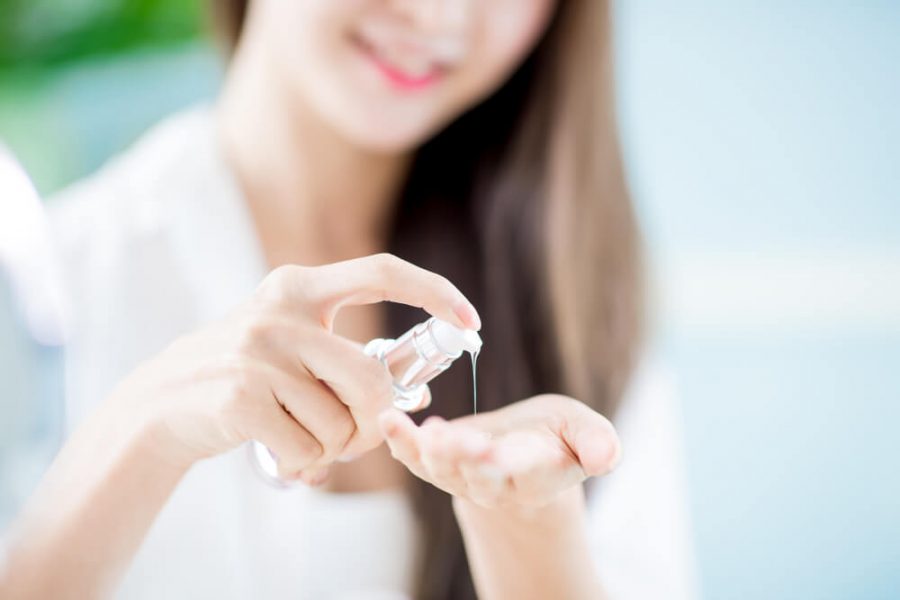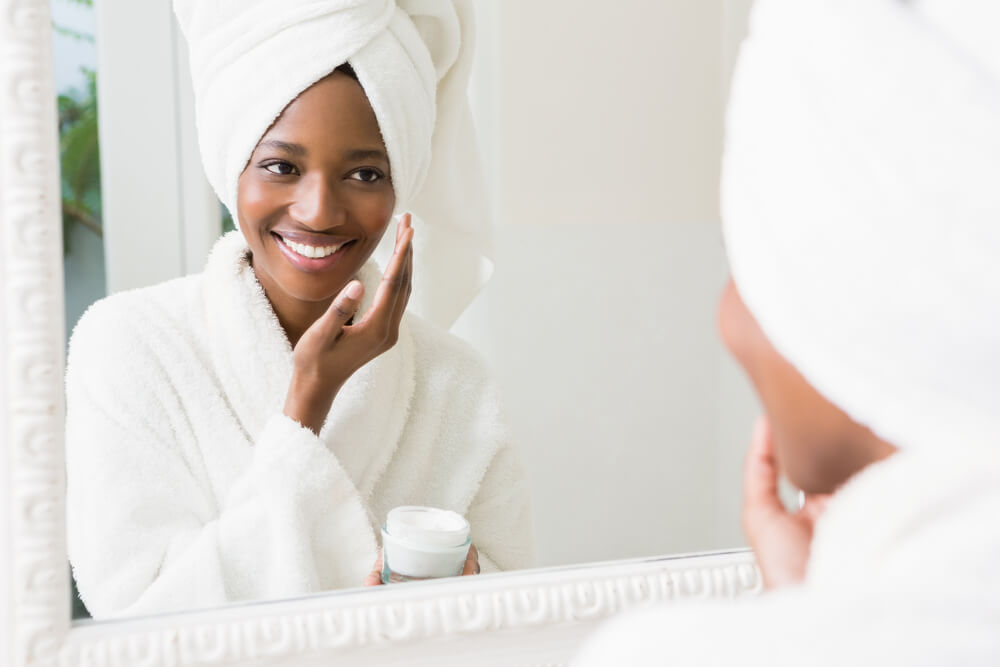Published: February 19, 2021
We’ve all been there: you wake up, take a look in the mirror, and find that your skin has lost its glow. What gives? Dull-looking skin can plague even those of us with the best skin care routines. If you seem to have lost your lit-from-within look, these tips will get you back on track to luminous-looking skin.
What is dull skin?
Put simply, dull skin is skin that looks flat and lifeless. It lacks the glow characteristic of radiant-looking skin. Dull skin can be caused by a number of things, from dehydration to using the wrong products. Luckily, there are a number of ways to treat it.
Here are 8 ways to rejuvenate the look of dull skin:
Rehydrate with Water

And we don’t mean upping your water intake. We’ve all heard the spiel that drinking water leads to better skin. While we do recommend it for your overall health (your organs will thank you), the jury’s still out on whether drinking tons of water leads to glowier skin.
Here’s what we mean:
Apply your skincare while your skin is still damp. We recommend immediately applying a hydrating toner or serum after your shower or after washing your face. This helps lock in hydration and leads to better product absorption.
Here’s what to look out for:
Look for watery, hydrating steps like our Facial Toner, which has both glycerin and sodium hyaluronate, two humectants with moisture-binding properties.
Other humectant ingredients to keep an eye on include lactic acid, aloe vera, honey, seaweed, and collagen. These water-loving ingredients will help address your skin’s dull look in no time.
Layer Your Skincare
Not everyone is blessed with naturally beaming skin. To combat dull-looking skin, you can’t just rely on your regular moisturizer. Layering your skincare can provide you with the hydration and moisturization you need to rejuvenate the look of dull skin.
While you don’t need a full 10-step routine, applying a hydrating layer like a watery toner or a serum and then locking it in with a thicker moisturizer can do wonders, tackling the appearance of dullness caused by dryness and dehydration.
Exfoliate Regularly

One major cause of dull-looking skin is a buildup of dead skin cells. This leaves your complexion looking rough and lackluster.
Here’s how to counter it:
Exfoliating, whether physically or chemically, can help address the appearance of dullness that accompanies a build-up of dead cells. Using a gentle physical exfoliator, like the Rhodium Complex Facial Peeling, two to three times a week will help slough off dead skin cells to reveal brighter-looking skin.
Incorporate Vitamin C
Adding vitamin C to your routine is always a good idea—after all, it’s one of the gold standard ingredients for brightening the look of the skin.
It’s also loved for how it reduces the appearance of fine lines and wrinkles, giving the skin a tighter look.
Combined with a good sunscreen, you’ll be well-equipped to battle dull-looking skin caused by sun and environmental damage.
Here’s what to look out for:
The tricky thing about vitamin C is finding the right formulation. Ascorbic acid is the purest and strongest form of vitamin C; it’s also the most unstable, oxidizing when exposed to light and air.
It’s why most ascorbic acid products come in dark, opaque bottles (as they should), so when looking for ascorbic acid products, pay attention to the container they’re stored in.
How to choose the right ascorbic acid product:
When it comes to ascorbic acid, it’s important to choose the right concentration. We recommended starting at around 10% and making your way up to 15%, the middle ground at which it’s both more effective and less irritating.
You’ll also want to make sure that your ascorbic acid has a low enough pH level to ensure that it’s absorbed by the skin—ideally, that would be around 3.5 pH.
What about other forms of vitamin C?
Other forms of vitamin C such as magnesium ascorbyl phosphate and sodium ascorbyl phosphate are less finicky than ascorbic acid.
Products with these forms of vitamin C are less likely to degrade and work at neutral pH levels, meaning they’re much gentler on the skin.
Regardless of what vitamin C product you pick, we recommend applying it on bare skin to increase absorption and using it in conjunction with a broad spectrum sunscreen.
Use Products with Niacinamide

Like vitamin C,niacinamide is another powerhouse ingredient backed up by research. A form of vitamin B3, niacinamide can minimize the feeling of inflammation and reduce the appearance of hyperpigmentation and fine lines —all of which contribute to brighter-looking skin.
Here’s how to incorporate niacinamide into your routine:
A moisturizer, serum, or toner with niacinamide is easy to use: just apply it as directed and let your skin reap the benefits.
Use a Gentle Cleanser
You might be washing your face wrong. If you’re still using soap instead of a dedicated face wash, do yourself a favor and pick up a gentle cleanser. While soap might work fine for your hands and body, your facial skin is far too delicate for its high-pH, stripping suds.
What to look out for:
Avoid face washes with sodium lauryl sulfate or sodium laureth sulfate. These surfactants are known irritants that can strip the skin of its natural oils, which leads to dry, dull skin. If your skin feels tight and squeaky clean after a cleanse, that’s a bad sign: your skin should feel comfortable, not parched, after washing.
Invest in a Humidifier

No matter how much you’re hydrating your skin to combat dullness, it will all be for naught if you live in a harsh, dry environment.
Remember humectants, the hydrators that draw water from their surroundings? Those ingredients can actually dehydrate your skin if they can’t pull any moisture from the air.
How?
By drawing moisture from the deeper layers of your skin, only to have it evaporate on the surface.
If you live in a humid climate, you’re in luck. But if you’re one of the unlucky ones who live someplace dry, or if you’re suffering through a particularly dry winter, a humidifier can help.
Here’s how it works:
When it comes to tackling dullness, keeping your skin hydrated and moisturized is key. A humidifier pumps moisture back into the air to increase air hydration levels.
When you use a humidifier, moisture is less likely to evaporate from your skin’s surface.
Use Sunscreen Regularly
Using sunscreen is one of the most important steps in any skincare routine. You should be using sunscreen everyday. You might not recognize its immediate effects, but your skin will thank you in the long run.
Sunscreen protects your skin from the sun’s harmful rays. Not only does using sunscreen help prevent sunburn and reduce your risk of skin cancer, but it also slows down the effects of premature aging such as fine lines, wrinkles, sun spots, and dullness.
How to incorporate sunscreen into your routine:
If you haven’t used sunscreen in a while, you might think of it as the thick, greasy, white goop of your childhood summers.
Luckily, that’s no longer the case. Nowadays, sunscreen formulations are much more sophisticated and cosmetically elegant than their previous incarnations.
For good reason, too: you need about half a teaspoon of sunscreen just to protect your whole face. A good sunscreen won’t look greasy or leave a white cast, even at that amount.
Make sure you’re applying sunscreen after your skincare routine and before putting on makeup. If you’re getting constant sun exposure (yes, even from a window), reapply your sunscreen every two hours.
What to look for in a sunscreen:
When it comes to sunscreen, you have a lot of options. No matter what sunscreen you choose, make sure that it indicates broad-spectrum protection. This shields you from both UVA (which causes premature aging) and UVB (which causes your skin to burn).
Experts recommend using sunscreen with an SPF of at least 30. If you have an active lifestyle, look for a water-resistant sunscreen to prevent water or sweat from washing it off.
Physical versus chemical:
Your sunscreen can be physical, chemical, or a combination of the two. Physical sunscreens, like zinc oxide and titanium dioxide, sit atop the skin to deflect UV rays.
Chemical sunscreens, like avobenzone, octinoxate and oxybenzone, on the other hand, are absorbed by the skin. These chemical filters then absorb UV rays and convert them into heat, which is then released from the skin.
Dull-Looking Skin: The Bottom Line
All of us, at one time or another, have dealt with dull-looking skin. In short, keeping your skin feeling healthy is the first step to combatting the appearance of dullness. That can mean doubling down on hydration, choosing the right products to boost your skincare, and keeping your skin protected from environmental damage.


